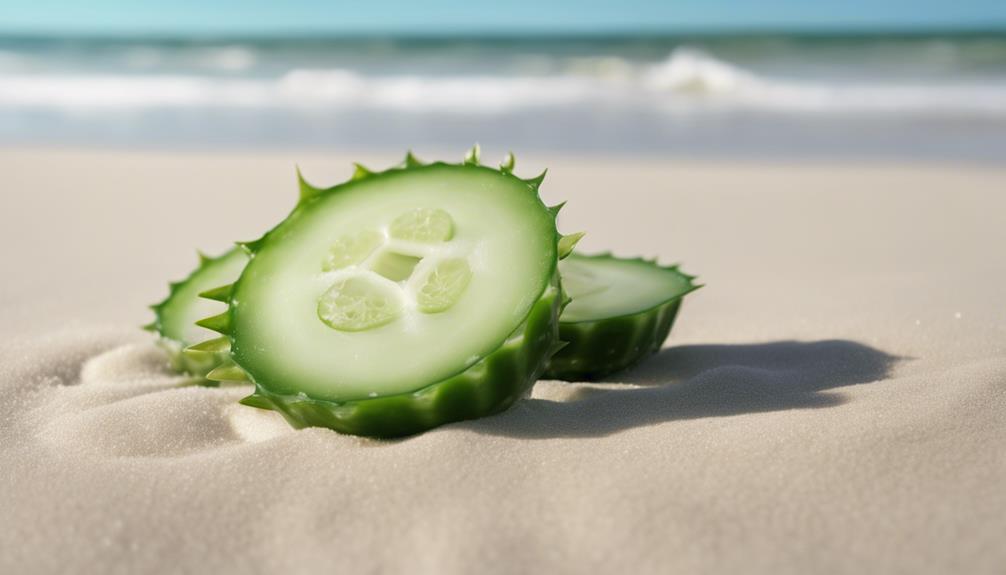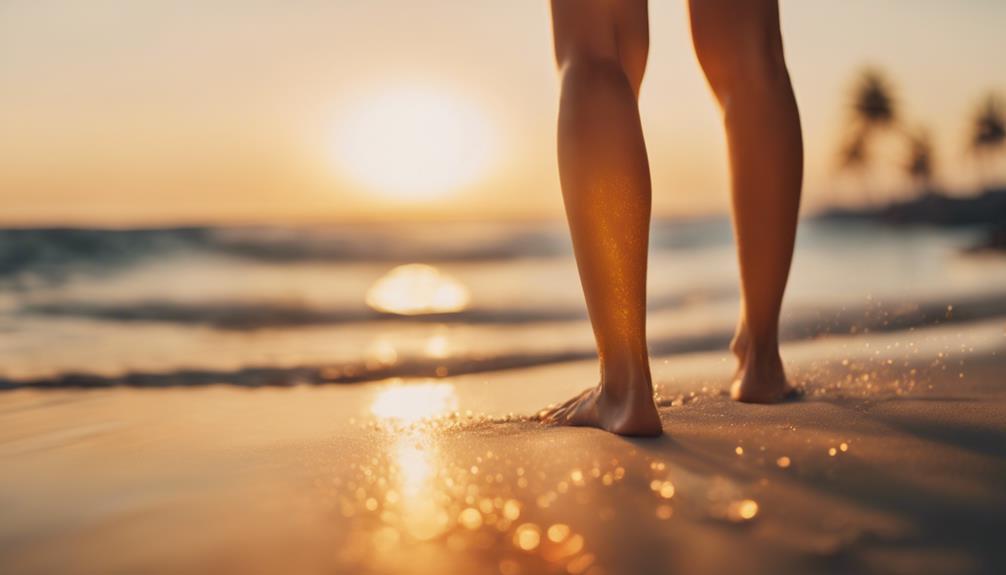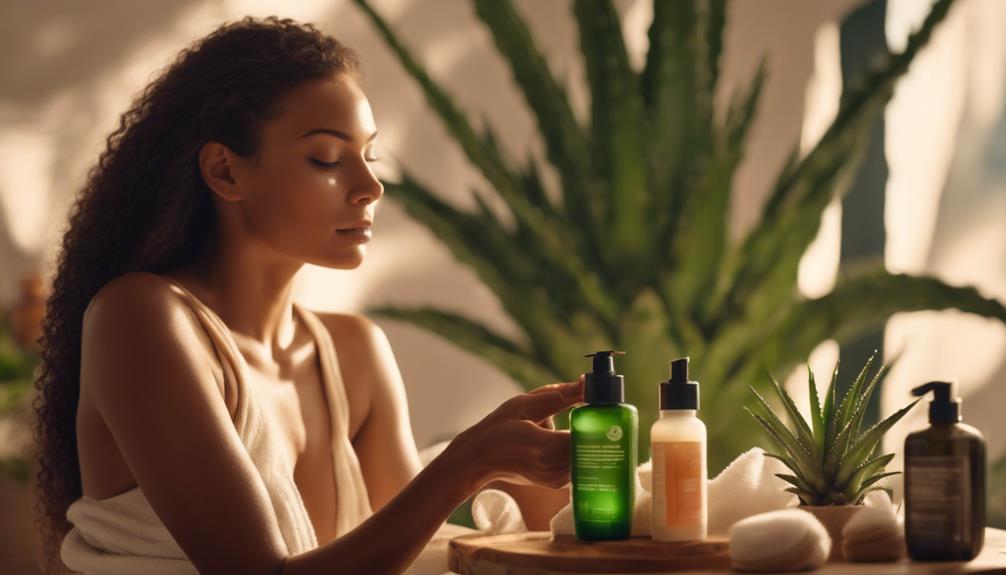You've just basked in the sun, and now your skin's crying for relief! No worries! Natural remedies like aloe vera and coconut oil are your best friends. Aloe vera's cooling magic soothes and hydrates, while coconut oil locks in moisture and fights irritation. Want to kick it up a notch? Try an oatmeal bath for some blissful hydration or a chamomile compress to tackle redness. And don't forget to sip on that water to stay hydrated! These easy-peasy solutions not only comfort your sun-kissed skin but also help it recover. Stick around, and you'll discover even more tips for skin care!
Key Takeaways
- Apply aloe vera gel to soothe and hydrate sunburned skin, promoting recovery and cooling relief.
- Use coconut oil to lock in moisture and create a protective barrier against irritation.
- Take oatmeal baths for 15-20 minutes to calm itchiness and hydrate sun-exposed skin.
- Create a chamomile tea compress to reduce redness and provide gentle relief.
Natural Remedies for Relief
If you've spent too much time in the sun, natural remedies like aloe vera and coconut oil can provide the relief your skin craves.
Aloe vera is like a best friend for your sunburned skin, soothing and hydrating while helping you recover. Just imagine slathering it on and feeling that instant coolness!
Coconut oil, on the other hand, dives deep into your skin, locking in moisture and keeping irritation at bay—talk about a two-in-one miracle! Plus, both have anti-inflammatory properties that work wonders.
Don't forget chamomile tea, too! A cold compress with it can ease redness and calm your skin.
Soothing Techniques to Try

Try incorporating soothing techniques like oatmeal baths and green tea compresses to effectively calm and hydrate your sun-exposed skin.
Oatmeal baths are super easy—just sprinkle some finely ground oats into lukewarm water, hop in for 15-20 minutes, and feel those itchy sensations melt away. It's like a mini spa day right in your tub!
For a revitalizing green tea compress, steep tea bags in hot water, let them cool, and then place them on your skin for 10-15 minutes. You'll not only look like a relaxation pro but also feel that redness fade away.
These simple tricks can turn your post-tan skin care from blah to ahh, making your skin feel cozy and loved again. So go ahead, pamper yourself!
Essential Ingredients for Healing

Natural ingredients like aloe vera, coconut oil, and chamomile tea play an essential role in healing sun-exposed skin and restoring its comfort. These natural ingredients are known for their soothing and moisturizing properties, making them perfect for alleviating the effects of sunburn and sun damage. Additionally, they can also be found in many skincare products such as lotions, creams, and flawless selftanning sprays, offering a gentle and nourishing way to achieve a sun-kissed glow without the harmful effects of UV rays. With their healing benefits, incorporating these natural ingredients into your skincare routine can help maintain healthy, radiant skin even after prolonged sun exposure.
Aloe vera's gel-like goodness soothes your skin, making it feel as cool as a cucumber—no kidding!
Coconut oil swoops in to provide deep hydration, like a revitalizing drink for your thirsty skin.
And let's not forget chamomile tea, which isn't just for sipping; it's a gentle hero against redness.
When you combine these natural wonders, you're giving your skin the TLC it craves.
Plus, they all smell fantastic, making your post-tan routine feel like a spa day at home!
Tips for Effective Skin Care

To effectively care for your skin after tanning, focus on hydration and gentle exfoliation to promote healing and restore your natural glow.
Start by applying soothing aloe vera gel; it's like a cool drink for your skin!
Next, consider indulging in an oatmeal bath; the finely ground oats can work wonders, calming irritation while giving your skin a soft touch.
Don't forget about coconut oil, which acts as a protective barrier against the elements.
You can also brew some chamomile tea, let it cool, and use it as a compress for extra relief.
Remember, skin care isn't just a chore—it's a chance to pamper yourself and keep your skin happy, too!
You're worth it!
Hydration Strategies for Recovery

Hydrating your skin after tanning is essential for recovery, as it helps replenish moisture lost during sun exposure and promotes healing. So, let's explore some fantastic hydration strategies! You'll want to use products that soothe and restore your skin's moisture. Check out this handy table for some ideas:
| Hydration Method | Benefits | Application Tips |
|---|---|---|
| Aloe Vera Gel | Soothes and hydrates | Apply directly after sun exposure |
| Coconut Oil | Locks in moisture | Use as a massage oil |
| Oatmeal Baths | Calms and rehydrates | Soak for 15-20 minutes |
| Milk Compress | Softens skin and reduces irritation | Apply with a cloth for 10 minutes |
Try these methods to keep your skin happy, healthy, and glowing!
Prevention Techniques to Consider

Effective prevention techniques can greatly reduce the risk of sun damage and keep your skin healthy.
First off, slather on a high SPF sunscreen every two hours, even on cloudy days—yes, the sun can still sneak up on you!
Don't forget to seek shade between 10 a.m. and 4 p.m., when the sun's rays are at their strongest.
Wearing protective clothing, like wide-brimmed hats and sunglasses, not only makes you look cool but also shields your skin.
And hey, stay hydrated! Drinking water helps your skin bounce back from sun exposure.
Remember, a little planning goes a long way in keeping your skin happy and safe.
Importance of Natural Solutions

Natural solutions play an essential role in your post-sun care routine, helping to soothe and rejuvenate skin while minimizing irritation and promoting healing. These natural remedies aren't just gentle on your skin; they're like a cozy blanket for your sun-kissed body! Here's why you should embrace them:
- Gentle Ingredients: They're free from harsh chemicals that can irritate your skin further.
- Hydration Boost: Natural solutions, like aloe vera, pack a hydration punch, keeping your skin plump and happy.
- Healing Power: Many have anti-inflammatory properties, helping reduce redness and discomfort.
- Long-term Benefits: Regular use improves your skin's overall health, making it more resilient to future sun exposure.
Frequently Asked Questions
How Long Should I Wait Before Applying Aloe Vera After Tanning?
You should wait about 15 to 30 minutes after tanning before applying aloe vera. This allows your skin to cool down, ensuring better absorption and maximizing the soothing benefits of the aloe vera gel.
Can I Use Essential Oils for Post-Tan Skin Care?
Yes, you can use essential oils for post-tan skin care. Just remember to dilute them in a carrier oil to avoid irritation. Lavender and tea tree oils are great options for soothing sun-exposed skin.
Is It Safe to Exfoliate Sunburned Skin?
It's best to avoid exfoliating sunburned skin. Your skin needs time to heal, and exfoliating can cause further irritation. Focus on soothing and hydrating your skin instead, allowing it to recover naturally.
What Are Signs of Severe Sunburn Requiring Medical Attention?
Severe sunburn signals serious skin stress. If you spot swelling, severe pain, blisters, fever, or chills, seek medical support immediately. Protecting your skin's health is essential; don't ignore these alarming alerts that require attention.
Can Diet Influence Skin Recovery After Sun Exposure?
Yes, your diet can influence skin recovery after sun exposure. Consuming antioxidants, vitamins, and hydration-rich foods helps your skin heal faster, reducing inflammation and promoting overall health. Prioritize fruits, vegetables, and plenty of water for best results.
Conclusion
So, think of your skin as a thirsty plant, soaking up all that sunshine but begging for a rejuvenating drink afterward.
By using natural remedies like aloe vera and coconut oil, you're watering it back to life!
Just like a garden flourishes with love and care, your skin will thrive with the right attention.
So go ahead, treat your sun-kissed skin to some TLC, and watch it bloom back into its vibrant self, ready for more adventures in the sun!









